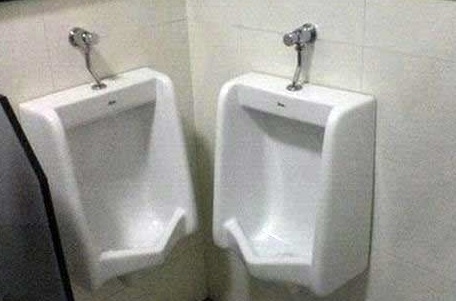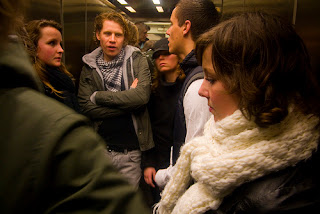Thanks to Peter for once again another fantastic contribution. Take it away, Peter:
An elevator is one of the few places in the world where
the least awkward way one can
possibly behave is to mutely stare downwards and focus on a spot between one’s
own two feet. The rules of
courteous communication are turned upside down. Acknowledging anyone else’s presence is a faux pas because
everyone in the elevator wishes he were alone.
When one enters a crowded elevator, he does two things
to antagonize the people already inside: (1) he makes the chamber even more
packed, and (2) he lengthens the time it takes for everyone else to arrive at
their final destinations. Inside
the crowded elevator, shoulders rub and asses are grazed. If someone has bad breath, everyone
knows. But people don’t know whose breath it is. As a result, everyone judges everyone
while trying to seem as innocent as possible. Similarly, farting in a crowded elevator is so shameless
it’s almost admirable. Almost.
Closely behind the senses of smell and touch, the human
ability to hear is the third leading cause of elevator awkwardness. The person who uses an elevator ride as
an opportunity to chat up strangers is rare, but he exists. This person is usually uncomfortable
with silence, and, as a result, his forced conversation starters are the
awkward product of stress and impatience.
He does not realize that forcing people to think on their feet while enclosed
in a claustrophobic chamber is more awkward and insensitive than silence.
Less obvious but similarly awkward is continuing a
conversation with a friend on an elevator, even if the elevator is empty. First, the two people must decide who
enters the elevator first, whether they are going to the same floor, who pushes
the button, and then, based on the buttons pushed, how to steer the
conversation’s length in a manner such that it will end when the first person
gets off the elevator. Performing
these elevator-specific maneuvers makes it difficult to focus on what’s being
said. Second, the conversation must follow a watered-down route in case
someone else enters the elevator.
Suddenly curtailing a conversation when a third party enters makes
everyone present uncomfortable.
If two strangers are waiting for an elevator on the same
floor of the same building, and two elevators open simultaneously (which, granted,
is rare) the courteous gesture is to take different elevators and to decide to
do so without either talking to or looking at the other person. The rationale is similar to the logic
men use when choosing urinals in a public restroom that has four people and
eight stalls. When teaching my
class about diffusion, my ninth grade biology teacher explained that the
concept applies as strongly to human behavior as to liquid. When humans are shuttled into an
enclosed space, the eventual dispersion of people is as balanced as sugar in
water. In an enclosed area in
which personal space is violated, there is absolutely no way to avoid
awkwardness and, in the land of awkwardly enclosed spaces, the elevator is
king.
***
ADDENDUM (by Peter):
The elevator does have some competitors for the “Most
Awkward Enclosed Space” trophy, like the metro. Unlike elevators, a metro ride
contains a “who sits? vs. who stands?” dynamic. Is the person who stands a gentleman, or is he implicitly
insulting others by showing that he would rather stand uncomfortably than sit
next to anyone? In addition, metros
force patrons to think about race.
At 5:30 PM on weekdays at the Dupont Circle metro stop in Washington DC,
black people and white people face each other blankly about 15 feet apart. If the white side had muskets and wore
red coats, the metro station could stage a reenactment of a 19th
century battle between England and any African country it colonized. This racial divide arises because people
are quite affluent on one side of the Dupont Circle stop (I bet you can’t guess
which side!). In this way, the
sense of vision is a major source of metro awkwardness, for metros force people
to witness, and consequently confront, touchy issues like self-segregation,
incomplete integration, and monetary inequality.
While metros have similar issues as elevators do
regarding the senses of touch and smell, a way the two spaces differ is that
the sense of hearing is a source of awkwardness in elevators, while vision is a
source of awkwardness on trains. The
reasons, however, that I would much rather be on a train than in an elevator
are two-fold. First, metros are
larger, so, unless it’s during the heat of rush hour, there is relatively less
physical awkwardness. Second, it
is common to distract oneself by reading, listening to music, texting, etc. on
a metro. Elevator rides are too
short for reading, and often there is not enough space to put one’s book in
front of one’s face; personal music on an elevator can usually be heard by all
in the chamber; and, many cell phones don’t receive service in elevators, and
texting while standing up forces one to look down at an angle. Such a posture makes one seem like he
is checking out the other passengers.
***
ADDENDUM Part 2 (by Clay):
Brief anecdote concerning urinals: One time at a squash tournament I warmed up on court with my opponent (whom I had just met for the first time) and then had to go to the bathroom right before the official match was to begin. I am at the urinal, whizzing away, and my opponent pulls up alongside me at the urinal to my right. We both give each other a stiff nod of acknowledgement and continue to pee in silence for the next 30 seconds. I shake off, zip up, and say a half-baked "good luck" to him as I leave the bathroom to step on the squash court where I'll be locked in a giant box with him, sweating and competing for the next 40 minutes.
N.B. I lost the match.
Second thing.
Trains.
Trains are a very funny thing. Most trains are setup such that there is an aisle in the middle and on both side rows of seats each with two seats. What makes things interesting is two facts: (1) most people commute/travel alone and (2) people ALWAYS prefer to sit alone on a two seater rather than right next to a stranger (people like their space). Thus as trains first begin to fill out, it is quite predictable and not very awkward: everyone finds a two-seater that they can take for themselves (i.e. no one chooses to sit down next to someone). However, there often comes a point (especially at busy commuting times) when all of the two seaters are taken, and people have to start to sit down next to a stranger.
What's funny about this is watching the selection process. Everyone knows when they are on a train so full where one more person entering will force someone to have to saddle up seats with a stranger. And when that person enters, everyone tenses up. It's amazing the things people will do. Everyone avoids eye contact with the person who is shuffling down the aisle. It is like watching a war criminal about to choose the next person to execute (where you might be the one chosen). Just as in the case of the war criminal eye contact might anger him and make him choose you as a result, in this case eye contact indicates you are a friendly person to sit with or somehow welcoming. Avoid eye contact. Do not smile. Make yourself look (without any words) as impolite and unfriendly and unwelcoming as possible. Put your bag in the empty seat as a passive aggressive gesture that you don't want company (or that your bag is sufficient company). Pretend to fall asleep so they'll be forced to awkwardly wake you up in order to sit with you. Stretch out on your seat in order to make it look like you naturally take up more room than you actually do. In this situation, the nice guy often gets screwed. No one chooses to sit with the people who look like dicks (and perhaps they project such an image for that very reason).
The worst is when you are the victim pathetically walking down the aisles looking for an empty seater. The first issue is logistical, one commonly called the "Secretary problem": after how many cars of looking for an empty two-seater should one stop looking and settle for sitting with someone. I am usually incredibly dogged in my search and will go literally until the end of the train in hopes of that single seater. I hate sitting next to people. The second issue is the obvious awkwardness, simply in the reverse of what was discussed earlier. Everyone is avoiding eye contact with you. You know what is on every single person's mind: "please God have this guy choose any seat but me." No one looks welcoming. You awkwardly bump people with your suitcase or backpack and have to apologize as you push through the aisles like a homeless tramp. Because of guilt, you procrastinate your decision to sit next to someone even long after you realize the chances of finding an empty two-seater are slim When you finally select your victim, his eyes drop in bitter disappointment and he grudgingly (though perhaps with a fake smile) moves his stuff aside and says "sure" in response to your pathetic "hey do you mind if I sit here?"





Peter I think that your piece is exceptionally well thought out - I like that you notice that awkwardness reaches one via different senses. I am sympathetic to the thought that smell is the sense most irritable qua awkwardness. Perhaps this is because it is the most invasive - part of someone else is literally inside you. Maybe I just think this way because I am exceptionally smelly. Peter, your piece is also well written. I can't say the same for Clay.
ReplyDeleteAfter reading this I lost a bit of hope for the study of awkwardness. It seems awkwardness is too subjective and those who desperately seek it out verge on being 'douchey' or 'douchebags', for lack of better terms.
ReplyDeleteI think I'm going to write a piece about this and submit it to awkwardize.
I think this blog and the philosophy majors behind it should try to define awkwardness. It would help the blog's cause and give more direction to what is obviously a good blog idea.
WHO ARE YOU!!!!
ReplyDelete20181017 junda
ReplyDeletecoach outlet
kate spade outlet
warriors jerseys
hermes belt
chrome hearts outlet
nhl jerseys
michael kors outlet
nike shoes
cazal sunglasses
air max 90